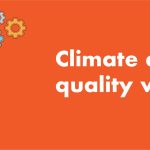Using Teal to Promote Dialogue and Collaboration Between Climate Scientists and the Transport Sector
Most global economies depend heavily on transportation, with passenger safety being a top priority. Some of the major stakeholders in this field include transportation planning and research agencies, state and local governmental authorities, road and rail commercial passenger carrier service providers, and freight goods transporters.
However, extreme weather events and climate change variations can affect these systems and have significant impacts on businesses. Hurricanes, floods, droughts, and storms all have immediate consequences, that affect day-to-day transport operations and cause significant clean-up and rebuilding costs.
How does historical climate data impact land based transportation sectors?
Expected climate change, such as rising temperatures and rainfall that may potentially lead to further adverse weather, will have long-term effects on all modes of transportation. Therefore, this sector would greatly benefit from knowledge on the impact of climate on various modes of transportation in order to establish successful planning and response measures.
Historical climate information can be used in several useful ways to benefit those in the commercial transport sector. However, in its raw form climate data can be difficult to use, for example for those without prior experience in climate science. TEAL has been created by WEMC to alleviate these obstacles and enables visualisation and generation of climate data into accessible, useful, and accurate products. For example, using TEAL to visually compare historical averages, extreme temperatures and precipitation data when planning for road and railway construction. Similarly reviewing historical rainfall amounts and incidence to plan for rainwater drainage systems.
The global climate and carbon emission data TEAL uses comes from reliable sources and tracks the past several decades, from around 1980 to near real time. A global map shows climate data by country and sub-country. These show as temporal time steps, through years, seasons, months and days. Teal datasets use historical reanalysis data (ERA5) from the EU Copernicus Climate Data Store as it is quality-assured, updated in close to real-time and at high resolution. The carbon emission data comes from the internationally reputable Global Carbon Project.
As the effects of climate change becomes more noticeable in the coming years, new information needs will emerge. TEAL can be used to promote dialogue and collaboration between climate scientists and the transportation sector towards sharing high quality, timely and appropriate data that is applicable towards this particular sectors’ needs. This type of information can help engineers and decision makers within this sector make practical and financial decisions in order to adapt to climate change and extreme weather conditions, and to mitigate possible effects.
Keep updated on Teal and share with us what you discover using Teal on Instagram, Twitter and LinkedIn. We are keen to hear how you use Teal as a resource within your specific sector.




